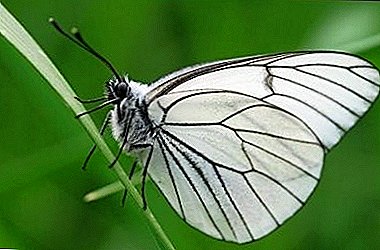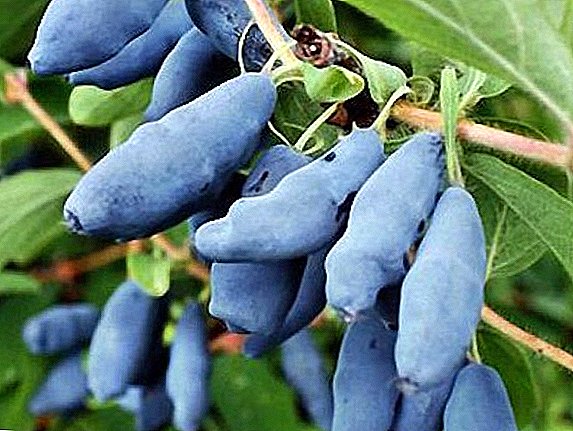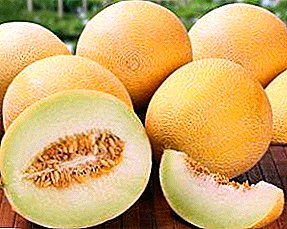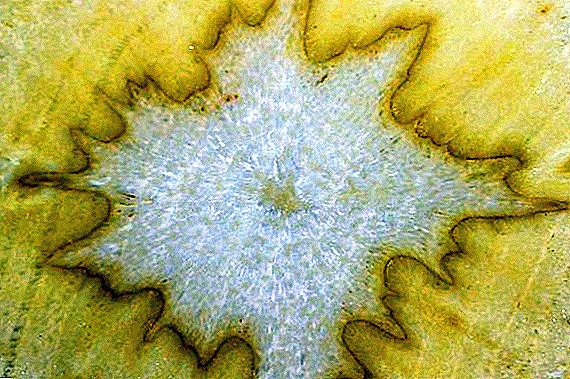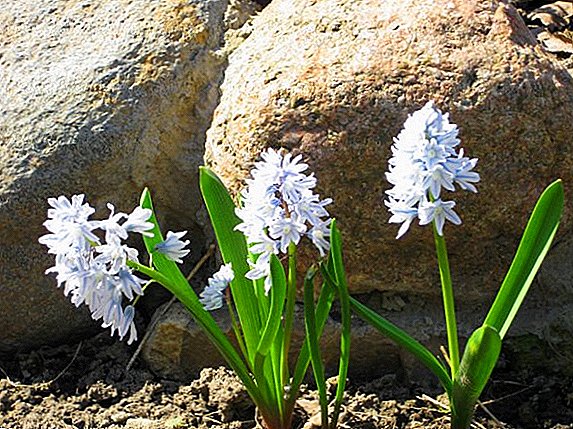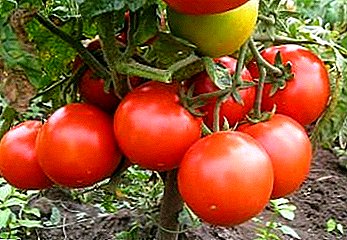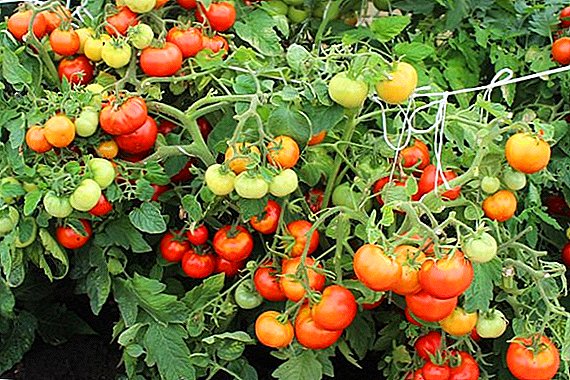 If only mushrooms would grow in the forest! But no - they are very frequent guests, in the form of infection, appear on garden beds. Cladosporium fulvum Cooke - so scientifically called a fungus, spoiling the brown spot leaves of growing tomatoes, the treatment of which from this misfortune, we intend to tell you today.
If only mushrooms would grow in the forest! But no - they are very frequent guests, in the form of infection, appear on garden beds. Cladosporium fulvum Cooke - so scientifically called a fungus, spoiling the brown spot leaves of growing tomatoes, the treatment of which from this misfortune, we intend to tell you today.
Description and harm
The name "brown spot" (the concept of "klaosporioz" is more common among specialists) shows the "appearance" of the disease - the spots of the corresponding color (already in the mature stage of the disease) cover tomato leaves.
But not only foliage is sick and dies. Launched cases of cladosporia tomato, left without timely treatment, lead to the death of the entire plant, and the owners in this case remain without the expected yield.
For tomatoes that are grown in greenhouses or under a greenhouse film, the threat of this disease is more than real, and you need to be prepared to treat the tomatoes growing in this way.
A disease goes through several stages in its development, which should exacerbate the vigilance of gardeners - to start a fight at the first signs means to conquer the illness, to allow the transition to the last stages - it means to lose in the fight against it.
Did you know? Spores of cladosporus were found at more than a kilometer of oceanic depth, in amber and on wood in sediments of the tertiary period - this is one of the most ancient fungal organisms.

Causes and pathogen
Not all varieties of tomatoes are resistant to cladosporia - this will be discussed below in more detail.
The first of the objective reasons for the infection of this disease is the natural susceptibility of a number of tomato varieties.
The second could be called environmental conditions - pathogens prefer heat (over +25 ° C) and humidity (over 80%).
The third reason is the increased penetrability of infection to objects of infection - this is due to the peculiarities of its pathogens.
Read also about how to get rid of Fusarium, powdery mildew, Alternaria, top rot, blight on tomatoes.
And they differ from the usual fungal spores. These are the so-called "conidia", with which Cladosporium fulvum Cooke reproduces asexually. Conidia “dust particles” are carried by the lightest air movements.  They settle on any items. By treating the beds with ordinary garden implements or by pouring them from the usual hose, you may not even suspect that at the same time you are transferring the pathogens of a tomato infection to plants that you love.
They settle on any items. By treating the beds with ordinary garden implements or by pouring them from the usual hose, you may not even suspect that at the same time you are transferring the pathogens of a tomato infection to plants that you love.
For the specificity of these carriers of the disease are characteristic:
- ability to live without the plant itself (they can live in the soil);
- resistance to drought and freezing temperatures;
- long (up to 10 months) viability.
Important! The decrease in air humidity below 70% stops the disease process.
The first signs in tomatoes
As soon as the brown spot touches your tomatoes, you need to immediately apply the known measures to combat it.
The possible first signs of cladosporia should be monitored during the growing season and the beginning of flowering. Do not be lazy at this time to look at the inner parts of the leaves - there, in the event of infection, appear, as at the very beginning of decay, gray spots.  A signal for inspecting the reverse side of the foliage can (and should) be fine light green (or, alternatively, yellowish) spotting on its outer side.
A signal for inspecting the reverse side of the foliage can (and should) be fine light green (or, alternatively, yellowish) spotting on its outer side.
In order not to return to the further description of the dynamics of the development of the disease, let us point out immediately and especially the subsequent steps:
- Kladosporiosis reaches its peak value, spreading from the bottom up, hitting not only the youngest leaves, but also parts of the stems.
Outwardly, this is expressed in the gradual darkening of the spots, and within the plant organism the supply of nutrients to all its areas and, consequently, the development of entangled fruit - seems to be intact and intact, grows very weakly and becomes mature.
- Dark brown spots indicate the final stage of the disease. The leaves dry up, fold, in the lower part is completely covered with rot.
Learn how to deal with brown spot on strawberries.
Treatment
From the moment the first painful symptoms appear, kladosporiosis or brown spotting of a tomato becomes an extremely unpleasant reality for you, which forces you to search for and apply the necessary treatment methods. They, by the way, a lot.
Chemicals
A significant part of land users come from cities. From here their weak acquaintance with national recipes of struggle against garden pests and diseases - the preference is given to chemical preparations which can be simply got in a specialized outlet.
We offer you the two most popular tools:
- Fungicides "NeoTek" and "Bravo" with a wide range of very strong action, capable, in an excessively concentrated form, burn the foliage.
In this regard, it is recommended not to deviate from the instructions from the official instructions when proceeding with the preparation of the working solution.
And for the final eradication of the infection, a second fungicidal treatment should be carried out - two weeks after the first.
- A complex solution of polycarbacin (a tablespoon), copper sulfate (the same amount) and colloidal sulfur (three times a tablespoon) is in a decaliter of water.
It is necessary to dissolve as much as possible. For a highly advanced spotting stage, some more liquid soap is added to the medication.
In addition to processing the seedlings themselves, with particular attention to the lower parts of the sheets, it is recommended to slightly irrigate the soil for the destruction of fungal spores there.

Important! Chemistry is better not to use in the early stages of the disease, it can have an adverse effect on the formation and ripening of the tomato ovary. Start with preventive examinations, manual removal of suspicious leaflets and, if the infection has already appeared, with gentle folk remedies.
Biological preparations
Biological products are good for their harmlessness to people, animals and beneficial insects. It is recommended to use trichodermin against cladosporia specifically (it is effective against other fungal diseases).
Bring it, for the first time, directly into the soil before planting seedlings. After that apply every month, simultaneously with watering.
In addition, spraying is performed with a solution (according to the instructions) of a liquid substance of the leaves of tomato bushes.
Considering that the dissolved trichodermin dries very quickly, the procedure should be carried out in cloudy weather to avoid additional heating of the greenhouse by the sun's rays. Read more about preventive biologics. 
Folk remedies
From completely natural means we will select whey divorced in water (1 liter for a bucket). Appropriate spraying is effective against both cladosporia and other undesirable fungi.
And two more prescriptions for which pharmaceutical preparations will be required:
- In 500 ml of warm milk (fresh) add 15 droplets of iodine, stir and pour into 5 liters of warm (or just warm) water.
Next is the standard spraying procedure with a more thorough treatment of the leaves in their lower part.
- Solutions of manganese and decoction of wood ash, which are recommended to be used alternately (with a weekly interval), will be completely harmless (both for the plant and for the man).
In this case, the finished manganese solution should be pink, and the medicine from the ashes is prepared by boiling 0.3 kg of the substance in a small volume of water and subsequent 20-minute languor on low heat, and only then the mixture is diluted in a ten-liter bucket.
Agricultural Techniques
Defeating kladosporioz using agrotechnical methods can only be the most radical way - to destroy all infected plants.  Therefore, agrotechnical techniques in this case should be considered either as an element of the integrated control of the disease, or as a purely prophylactic agent.
Therefore, agrotechnical techniques in this case should be considered either as an element of the integrated control of the disease, or as a purely prophylactic agent.
These could include:
- Destruction (burning) of infected leaves and the rest of the plant mass after harvesting.
- Strict adherence to the rules of crop rotation.
- Periodic airing of the greenhouse.
- Sparseness planted bushes.
- Optimization of watering in order to avoid waterlogging.
Prevention
For the prevention of brown spot use, firstly, the already mentioned solutions of potassium permanganate and wood ash.
The preventive treatment of plants is also done:
- copper oxychloride;
- Bordeaux liquid (1% solution);
- bioactive substances (Integral, Pseudobacterin 2, Fitosporin M).
 Finally, the greenhouse itself, where tomatoes are grown, should not be a haven for infection - its wooden components are treated with special solutions for this.
Finally, the greenhouse itself, where tomatoes are grown, should not be a haven for infection - its wooden components are treated with special solutions for this.Resistant varieties
To grow varieties of tomatoes that are resistant to cladosporia can also be considered a certain kind of prevention.
There are at least two such varieties. Of the most well-known tomatoes, many put the variety “Our Masha F1” in the first place, because, besides resistance to this disease, it also has excellent fruits.
Among the first are also called varieties:
- "Vezha", who came to us from Belarus (loses a little to the first place with the size of fruits).
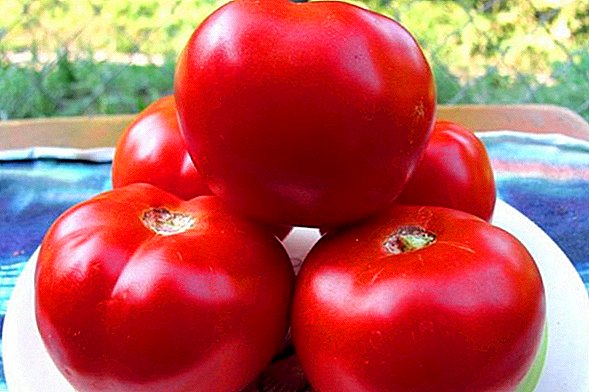
- "Delicacy" with pink tomatoes.

- "Space Star F1" - it is desirable to additionally spray it with additional prophylactic (“Alirin-B” and / or “Gamair” preparations).

- "Funtik" - its like "Evpator", start up, in the core, in processing, without using fresh.
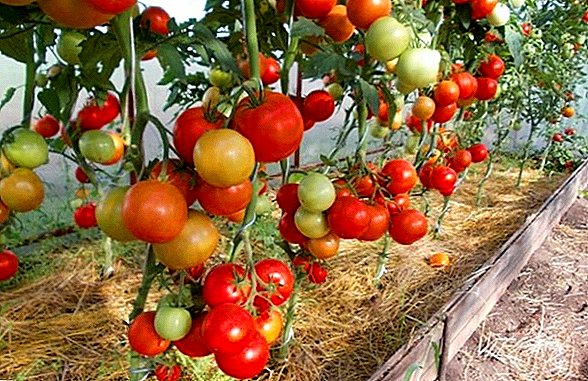
Did you know? Soviet scientist N.I. Vavilov pointed to South America as the genetic center of origin for the primitive form of tomatoes.
The specks that appeared on the leaflets of tomato seedlings should become a guide to action, especially the disease is curable. With a little effort, a good harvest awaits you.







